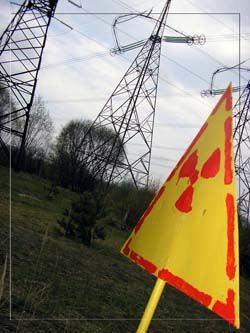The Chornobyl Brand

For most Ukrainians, as for other peoples in the region, Chornobyl is synonymous with the world’s most serious nuclear disaster, the subsequent cover-up by the communist regime, and thousands of displaced people. However, around the world Chornobyl has acquired a certain form of renown, turning it into something more. As the world’s only post-nuclear wasteland, Chornobyl has become a one-of-kind tourist attraction, one whose fame almost exceeds that of the country in which it is located, joining the ranks of such places like Auschwitz or Hiroshima.
Chornobyl’s appeal for many foreign thrill-seekers is accentuated by the fact that it is shrouded in mystery. An apocryphal claiming that chornobyl is the Ukrainian translation of wormwood – both a bitter-tasting plant used in absinthe production (and as a basis for herbal medicines), and a celestial being from the Book of Revelations that death to many by poisoning the waters – led many to believe that the Chornobyl disaster was in fact a harbinger of the apocalypse:
“And the third angel sounded, and there fell a great star from heaven, burning as it were a lamp, and it fell upon the third part of the rivers, and upon the fountains of waters; And the name of the star is called Wormwood: and the third part of the waters became wormwood; and many men died of the waters, because they were made bitter.” Revelation 8:10
The reference to the burning lamp and poisonous waters are indeed eerily reminiscent of the disaster itself, as water, which tends to soak up radiation, was one of the major sources of contamination. Actually, the wormwood plant, known as polyn hirky in Ukrainian, is a close cousin of the chornobyl plant. While for some this proves that the incident had nothing Biblical about it, it also left just enough room for those with inclinations for the strange to create the Chornobyl myth.
Ukraine has capitalized on this myth in several ways already, the most famous of which is STALKER, arguably the best game to date to come out of the country. It was produced by the Kyiv-based GSC Game World, also known for its successful Cossacks series. Loosely based on the 1973 Andrei Tarkovsky film of the same name, it tells the story of an artefact hunter in the exclusion zone surrounding Chornobyl, which has been rendered even more outlandish by a second nuclear explosion. Very successful both on the domestic and international markets, STALKER sold over two million copies, and has since seen two further installments.
Yet the virtual tour provided by the STALKER games is not enough for the most daring travellers. For this reason the Ukrainian government has authorized tours of the exclusion zone from 2002 onwards. Since then, nearly ten different travel agencies offering both personal and group tours to the area have sprung up. Large groups can book tours for $110-150 per person, while individual excursions can cost up to $600. Some travel agencies offer two or three-day packages, combining the Chornobyl visit with sight-seeing in Kyiv and a guided tour of the Chornobyl museum located in the Podil district. The latter can be particularly useful for foreigners as the Chornobyl museum, while being very well designed and containing lots of interesting material, has a regrettable lack of English-language explanations (though English-speaking guides can be hired for a reasonable sum).
In the course of the 10-12-hour trip, visitors meet with some representatives of Chernobylinterinform, a governmental body responsible for site management and monitoring the visitor’s health. They visit the abandoned city of Pripiat, whose 46,000 inhabitants were evacuated following the meltdown. Visitors also get a chance to take photos in front of the infamous Reactor 4, that radioactive waste over Ukraine, Belarus and other countries in the region. The reactor is currently covered with a rapidly deteriorating concrete sarcophagus – an EBRD-managed project aims to build a second layer covering it by 2012. The visits finish off with short trips to the local marina, amusement park, and/or villages that have been resettled.
Although visitors are required to sign forms stating that they are aware of the potential health risks, these are relatively small. Over 10,000 people live in the zone, having either refused to leave or resettled. It appears that they haven’t suffered from any widespread radiation-related illnesses, suggesting that outside certainly highly contaminated areas, the region is generally safe. A 2006 report by the United Nations Scientific Committee on the Effects of Atomic Radiation has found that, while tragic in its immediate consequences, “from the radiological point of view, generally positive prospects for the future health of most individuals [affected by the accident] should prevail.”
The greatest impact of the Chornobyl disaster has been on the region’s wildlife. Numerous studies have found that, freed from the deleterious effects of human settlement, many endangered species, including the lynx, European Bison, and Przewalski’s Horse (which was brought back from the verge of extinction), have seen their numbers surge. Thus, the area around Chornobyl has involuntarily been turned into a wildlife haven, leading the UN to suggest that the area become an ecotourism hotspot.
The Chornobyl disaster caused many tragic deaths. Thousands have suffered from radiation illnesses and relocation. However, like the vegetation pushing through the concrete walls of Pripiat’s buildings, green shoots are appearing for the region. Chornobyl may not be the best image for Ukraine to build its international “brand” upon, but it will certainly remain one the most unique and widely-known tourist destinations in the country. It can, with time and luck, acquire new symbolic importance for the Ukrainian nation: that through effort and entrepreneurship one can turn even a bad situation into something of value.
Newspaper output №:
№26, (2010)Section
Nota bene





